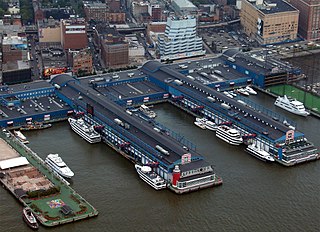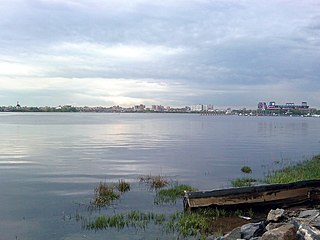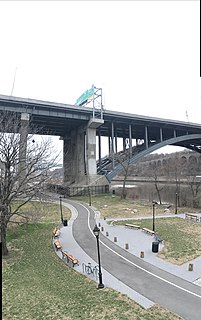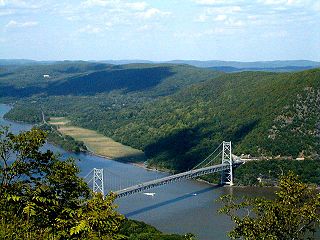
North River is an alternative name for the southernmost portion of the Hudson River in the vicinity of New York City and northeastern New Jersey in the United States. The entire watercourse was known as the North River by the Dutch in the early seventeenth century; the term fell out of general use for most of the river's 300+ mile course during the early 1900s. However the name remains in very limited use as an artifact among history-inclined local mariners and others and on some nautical charts and maps. The term is also used for infrastructure on and under the river, such as the North River piers, North River Tunnels, and the North River Wastewater Treatment Plant.

East River Park, also called John V. Lindsay East River Park, is 57.5-acre (20 ha) public park located on the Lower East Side of Manhattan, part of the New York City Department of Parks and Recreation. The park stretches along the East River from Montgomery Street up to 12th Street on the east side of the FDR Drive. The southern entrance boasts good views of the Manhattan Bridge and Brooklyn Bridge. The amphitheater, built in 1941 just south of Grand Street, has been reconstructed and is often used for public performances. The park includes football, baseball and soccer fields, tennis, basketball and handball courts, a running track and bike paths including the East River Greenway. Fishing is another popular activity. The park is bisected by the Williamsburg Bridge.

Carl Schurz Park is a 14.9-acre (6.0 ha) public park in the Yorkville neighborhood of Manhattan, New York City, named for German-born Secretary of the Interior Carl Schurz in 1910, at the edge of what was then the solidly German-American community of Yorkville. The park contains Gracie Mansion, the official residence of the Mayor of New York.

Chelsea Piers is a series of piers in Chelsea, on the West Side of Manhattan in New York City. Located to the west of the West Side Highway and Hudson River Park and to the east of the Hudson River, they were originally a passenger ship terminal in the early 1900s that was used by the RMS Lusitania and was the destination of the RMS Titanic. The piers replaced a hodgepodge of run-down waterfront structures with a row of grand buildings embellished with pink granite facades.

Exchange Place is a district of Downtown Jersey City, New Jersey, United States, that is sometimes referred to as "Wall Street West" due to the concentration of financial companies that have offices there. The namesake is a square, about 200 feet long, at the foot of Montgomery Street at the Hudson River. This square was created by landfilling the shore at Paulus Hook, and has been a major transportation hub since the colonial era.

Hudson River Park is a waterside park on the North River, and is the part of the Manhattan Waterfront Greenway that extends from 59th Street south to Battery Park in the New York City borough of Manhattan. It is a joint state and city collaboration, but is organized as a New York State public-benefit corporation. It is a 550-acre (2.2 km2) park stretching 4.5 miles (7.2 km), making it the second-biggest park in Manhattan after Central Park. The park arose as part of the West Side Highway replacement project in the wake of the abandoned Westway plan.

Flushing Bay is a tidal embayment in New York City. It is located on the south side of the East River and stretches to the south near the neighborhood of Flushing, Queens. It is bordered on the west by LaGuardia Airport and the Grand Central Parkway, on the south by Northern Boulevard, and on the east by the neighborhood of College Point. The Flushing River empties into the bay at its southeast corner. A 150-foot-wide navigational channel (46 m) dredged at a depth of 14 feet (4.3 m) runs along much of the bay's length.

Brooklyn Bridge Park is an 85-acre (34 ha) park on the Brooklyn side of the East River in New York City. Designed by landscape architecture firm Michael Van Valkenburgh Associates, the park has revitalized 1.3-mile (2.1 km) of Brooklyn's post-industrial waterfront from Atlantic Avenue in the south, under the Brooklyn Heights Promenade and past the Brooklyn Bridge, to Jay Street north of the Manhattan Bridge. The site includes Brooklyn Piers 1–6, the historic Fulton Ferry Landing, and the preexisting Empire–Fulton Ferry and Main Street Parks. Two Civil War-era structures, Empire Stores and the Tobacco Warehouse, will also be integrated into the park. The park is part of the Brooklyn Waterfront Greenway, a series of parks and bike paths around Brooklyn.

The Hudson River Waterfront Walkway, also known as the Hudson River Walkway, is an ongoing and incomplete project located on Kill van Kull and the western shore of Upper New York Bay and the Hudson River, implemented as part of a New Jersey state-mandated master plan to connect the municipalities from the Bayonne Bridge to the George Washington Bridge with an urban linear park and provide contiguous unhindered access to the water's edge.

The East Side of Manhattan refers to the side of Manhattan which abuts the East River and faces Brooklyn and Queens. Fifth Avenue, Central Park from 59th to 110th Streets, and Broadway below 8th Street separate it from the West Side.
The West Side of Manhattan refers to the side of Manhattan Island which abuts the Hudson River and faces New Jersey. Fifth Avenue, Central Park, and lower Broadway separate it from the East Side. The major neighborhoods on the West Side are West Harlem, Morningside Heights, Manhattan Valley, Upper West Side, Hell's Kitchen, Chelsea, West Village, SoHo, and Tribeca. The 8th Avenue and West Side subway lines connect all parts of the West Side. The main north-south roads servicing the West Side are the Henry Hudson Parkway in the north, and the West Side Highway in the south. The Hudson River Greenway separates them from the west shore of the island.

DeWitt Clinton Park is a 5.8-acre (23,000 m2) New York City public park in the Hell's Kitchen neighborhood of Manhattan, New York City, between West 52nd and West 54th Streets, and Eleventh and Twelfth Avenues.

Weehawken Port Imperial is an intermodal transit hub on the Weehawken, New Jersey waterfront of the Hudson River across from Midtown Manhattan, served by New York Waterway ferries and buses, Hudson–Bergen Light Rail, and NJT buses. The district lies under and at the foot of Pershing Road, a thoroughfare which travels along the face of the Hudson Palisades, which rise to its west. The Hudson River Waterfront Walkway runs along the shoreline and is abutted by recently constructed residential neighborhoods, Lincoln Harbor to the south and Bulls Ferry to the north.

The West Midtown Ferry Terminal is a passenger bus and ferry terminal serving ferries along the Hudson River in New York City and northeastern New Jersey. It is located at Piers 78 and 79 in Hudson River Park adjacent to the West Side Highway at West 39th Street in Midtown Manhattan. The municipally-owned facility opened in 2005 as multi-user terminal to accommodate an increasing demand for ferry service in the Port of New York and New Jersey and to provide ferry slips for short haul crossings, water taxis, and high-speed long distance service. Built largely with public funds the West Midtown became upon its opening one of the principal terminals used by the private NY Waterway-operated routes to Jersey City, Hoboken, Weehawken, and Edgewater.

The Sunset Park Greenway (SPGW) or Shore Parkway Greenway Connector is a 4.41 mile (7.10 km) long, signed cycle route traversing Sunset Park, Brooklyn with portions running through the adjacent neighborhoods of Bay Ridge, Borough Park and Kensington.

Robert Moses Playground is a 1.3-acre (0.53 ha) playground and park in the New York City borough of Manhattan. It is located in the Murray Hill neighborhood on First Avenue between 41st and 42nd streets, immediately south of the United Nations Headquarters. The park is named for New York's "master builder" Robert Moses.

The East River Greenway is an approximately 9.44-mile-long (15.19 km) foreshoreway for walking or cycling on the east side of the island of Manhattan on the East River. It is part of the Manhattan Waterfront Greenway. The largest portions are operated by the New York City Department of Parks and Recreation. It is separated from motor traffic, and many sections also separate pedestrians from cyclists. The greenway is parallel to the Franklin D. Roosevelt East River Drive for a majority of its length.

Bridge Park is a park in the Bronx, New York, created as part of a larger vision of creating connected waterfront parks along both sides of the Harlem River. The park’s name references three large arch bridges linking Manhattan and the Bronx: Alexander Hamilton Bridge, Washington Bridge, and High Bridge.

Barretto Point Park is a waterfront public park on the East River located in the Hunts Point neighborhood of the Bronx. Its namesake is Francis J. Barretto, a 19th-century merchant and State Assemblyman who lived in the area.


























